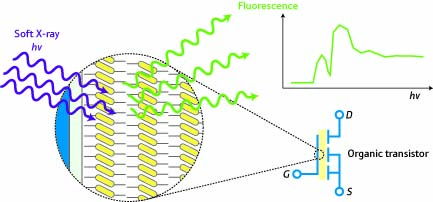Mar. 9, 2012 Research Highlight Physics / Astronomy
Taking a closer look at molecular electronics
Fluorescence-yield x-ray spectroscopy provides a view into how organic transistors work at the molecular scale
 Figure 1: X-rays (left) fall onto active molecules inside an organic transistor (bottom right), causing fluorescent emission. The intensity of the emission as a function of incident energy reveals information about the state of the emitting molecules (top right). © 2012 Hiroyuki Kato
Figure 1: X-rays (left) fall onto active molecules inside an organic transistor (bottom right), causing fluorescent emission. The intensity of the emission as a function of incident energy reveals information about the state of the emitting molecules (top right). © 2012 Hiroyuki Kato
Molecules and polymers have unique electronic and optical properties suitable for use in electronic devices. These properties, however, are complex and not well understood. Charge transport, for example, is affected by molecule shape, which can change during device operation and is difficult to measure. Now, a new technique is available to characterize the electronic states of molecules, thanks to research by Hiroyuki Kato from the RIKEN Advanced Science Institute and his colleagues in Japan1.
The key characteristic of the team’s technique—called fluorescence yield x-ray absorption spectroscopy—is its ability to probe molecules that are buried underneath other molecules, as well as under metallic electrodes (Fig. 1). First, x-ray photons illuminate a device of interest, causing core electrons inside a particular atom to be promoted to higher energy levels. When these electrons relax, they release their energy either to other electrons, or to photons, Kato explains. Finally, these energetic electrons or photons are emitted from the device, and the researchers can measure their energy. Then, they can determine the properties of the emitting molecule. The ability to select the type of atom that is excited—for example, carbon—aids the analysis.
Other researchers had previously monitored electron relaxation by observing emitted electrons. However, they were limited to observing molecules near the device surface since electrons have difficulty passing through other molecules and metals. Kato and colleagues therefore monitored the relaxation of excited electrons via emitted photons since they exit the device easily.
The researchers applied their photon-based technique to an organic thin-film transistor made with the molecule DH6T, which is a small polymer called an oligomer. As they operated the transistor by varying the voltage applied to the gate electrode, Kato and colleagues saw the emitted photon spectrum shift in real time. The dependence of this shift on wavelength and voltage showed that, contrary to expectations, the emitted photons were unaffected by charges induced by the gate voltage. Instead, their spectrum was determined entirely by the internal state of the probed molecules, even under an applied electric field.
Further analysis showed that this electric field was not distributed evenly across the oligomer; rather, it fell disproportionately across one of the chemical groups making up the oligomer. This conclusion represents a first look into the electric field distribution in molecular devices at the scale of individual molecules. Kato says he expects the technique will prove to be a valuable characterization tool for the building blocks of future electronic and optical devices.
References
- 1. Kato, H.S., Yamane, H., Kosugi, N. & Kawai, M. Characterization of an organic field-effect thin-film transistor in operation using fluorescence-yield x-ray absorption spectroscopy. Physical Review Letters 107, 147401 (2011). doi: 10.1103/PhysRevLett.107.147401
